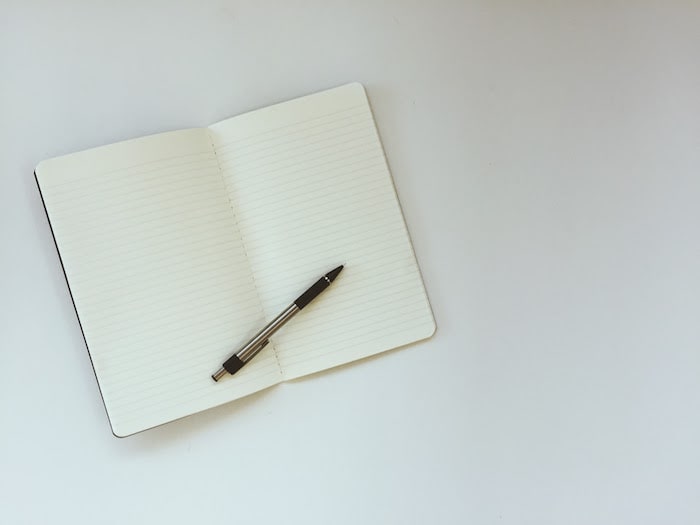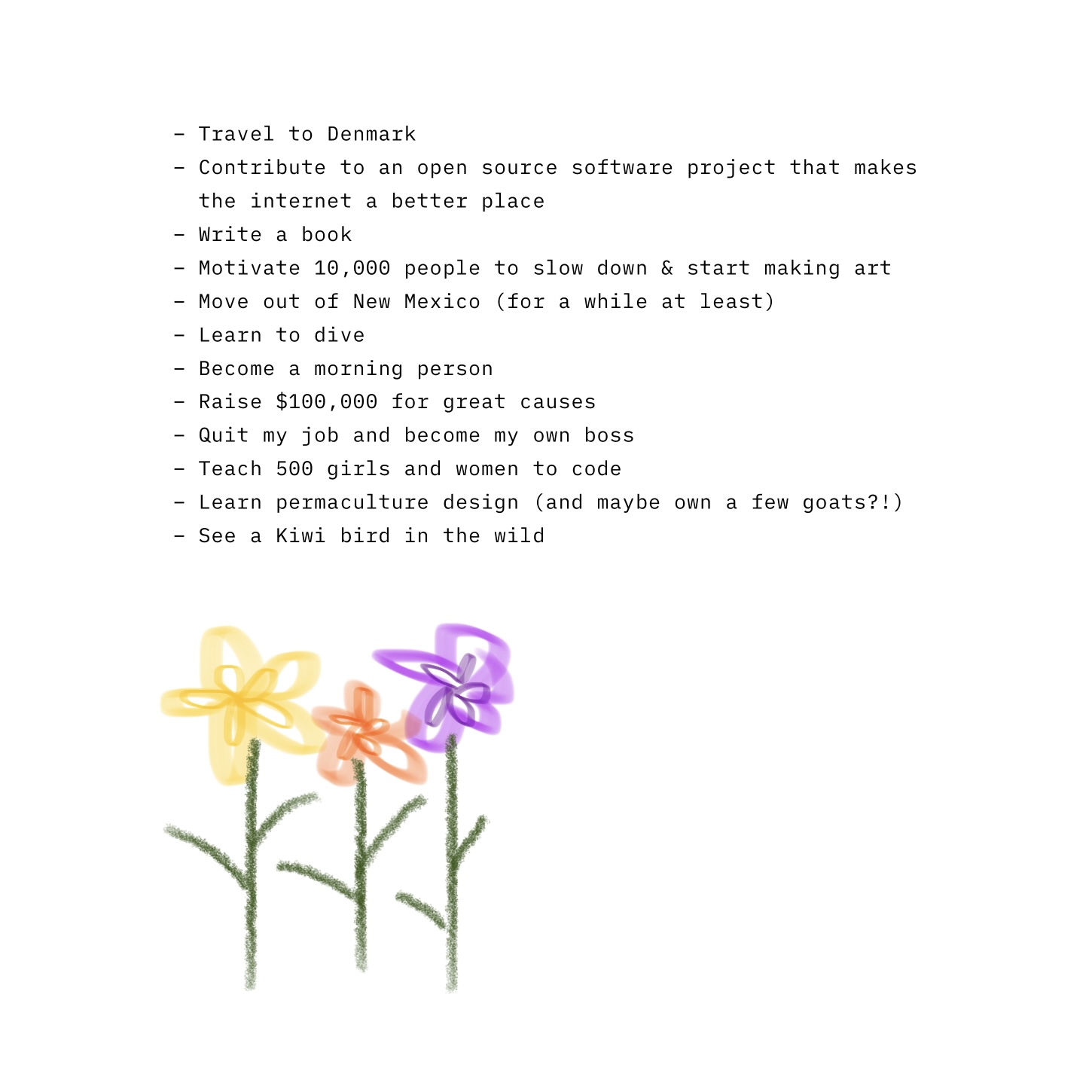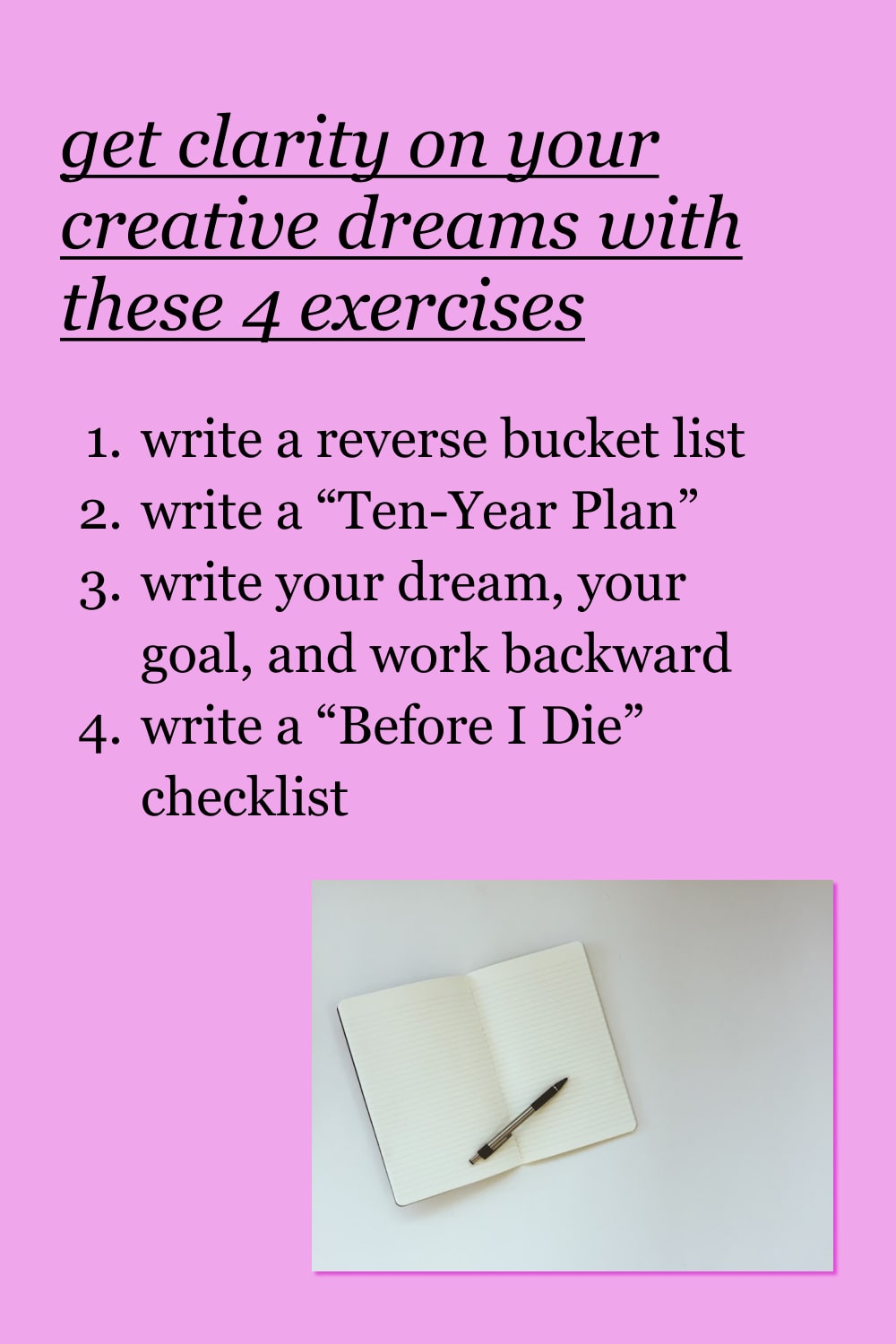Exercises for creative visioning: Four writing exercises to clarify your creative dream and stay inspired to reach your goals
When you begin building a creative practice, it can be helpful to build a more concrete vision for the world you're trying to build and the life you're trying to live.
Life is easier when you know what you want—but most people don't take the time to figure out what they want.
It's not that we are completely lost, but our efforts are often slightly misdirected. People will work for years and ultimately achieve a lifestyle that isn't quite what they were hoping for—often, simply, because they never clearly defined what they wanted.
An hour of thinking can save you a decade of work.

As I've built my own creative practice the past seven years, I've found a few exercises that have given me the clarity I seek:
- Write a reverse bucket list - a list of all the things you've _already_ accomplished; less about your vision for the future and more about grounding yourself in gratitude
- Write a Ten-Year Plan - a detailed narrative description of your ideal life ten years from now
- Write your dream, your goal, and work backwards - a concrete goal and shorter vision statement with a five-year plan for getting it done
- Write a "Before I Die..." checklist - a simple, short bucket list specifically for your items that signify you are living a centered and spacious creative life
If writing isn't your thing, feel free to do these exercises in whichever medium you prefer. Dictate into your phone or make a mixed media vision board.
I recommend doing all of these exercises at some point, but feel free to start with the one that excites you most.
Write a reverse bucket list #
I like to start my creative visioning sessions from a place of abundance and gratitude, which is why I recommend writing a reverse bucket list as the starting point.
The reverse bucket list is pretty straightforward: Rather than writing down all of the things you hope to one day achieve, you instead write down a list of all the things you’ve already accomplished, things that make you feel proud. It’s the exact opposite of a regular bucket list—and it’s an encouraging exercise. — Anna Meyer, Shine
You might think, "I don't have much to be proud of," which is just not true. I recommend starting with even the smallest accomplishment. Took care of my sister when my mom was working late. Wrote in a journal every day for a month. Saved up money for a special purchase. Wrote a poem in the 5th grade. Passed algebra. Wore bright blue eyeshadow to a friend's birthday party.
This is a grounding exercise. If you're not feeling particularly nostalgic, try listening to your favorite gratitude meditation (YouTube has so many!) before getting started.
Write a Ten-Year Plan #
In a 2017 podcast interview with Tim Ferris, designer Debbie Millman describes this creative visioning exercise that she learned as a student of Milton Glaser. She calls it "Your Ten-Year Plan for a Remarkable Life" and it's a detailed description of what you want your life to look like ten years from now. Here's Debbie's description of the exercise:
So let say it is Winter 2027. What does your life look like? What are you doing? Where are you living? Who are you living with? Do you have pets? What kind of house are you in? Is it an apartment are you in the city are you in the country? What does your furniture look like? What is your bed like? What are your sheets like? What kind of clothes do you wear? What kind of hair do you have?
Tell me about your pets, tell me about your significant other, do you have children? Do you have a car? Do you have a boat? Talk about your career. What do you want? What are you reading? What are you making? What excites you? What is your health like?
And write this day, this one day ten years from now. So one day in the winter of 2027, what does your whole day look like? Start from the minute you wake up, brush your teeth, have your coffee or tea, all the way through until minute you tuck yourself in at night. What is that day like for you?
Dream big, dreams without any fear. Write it all down. You don’t have to share it with anyone other than yourself. Put your whole heart into it. And write like there is no tomorrow; write like your life depends on it because it does.
And then read it, once a year, and see what happens.
It’s magic.
Write your Ten-Year Plan and then schedule a reminder a year from now to review it.
Thanks to Mayeu for the transcription of the exercise!
Write your dream, your goal, and work backward #
This exercise comes from "Week 8: Recovering a Sense of Strength" from Julia Cameron's book The Artist's Way. If you haven't worked your way through The Artist's Way 12-week program, I can't recommend it enough.
- Name your dream. That's right. Write it down. "In a perfect world, I would secretly love to be a __."
- Name one concrete goal that signals to you its accomplishment. On your emotional compass, this goal signifies true north.
- In a perfect world, where would you like to be in five years in relation to your dream and true north?
- In the world we inhabit now, what action can you take, this year, to move you closer?
- What action can you take this month? This week? This day? Right now?
- List your dream. List it’s true north. Select a role model. Make an action plan. Five years. Three years. One year. One month. One week. Now. Choose an action.
Write a "Before I Die" checklist #
What do you want to contribute to the world before you die?
This question came to me in Alexandra Franzen's newsletter on December 3, 2020. In it, Alex shared her Before I Die, I Will... list. It was written in big letters and posted on a bulletin board.
Her list inspired me to write my own. My list includes twelve items. It's exciting, motivating, and full of fun challenges. It doesn't feel overwhelming or fill me with anxiety, which is often how I feel when tasked with writing a bucket list.

Maybe you too just need to write your own list of 10-12 things to keep you focused on the big-picture? After you've written your list, can you focus on one item and get started right now? What if you break it down into its absolute smallest next step?
Even small, imperfect projects can make a big impact.

Subscribe to Soft Practice—An email newsletter for artists and makers
Soft Practice is about making art without an art degree, paying attention, and keeping the promises we make to ourselves. It's about practice. And quitting. And starting again.
It arrives in your inbox once a month (usually on a Sunday) and is best consumed with a hot beverage. In each newsletter I will share all the messy parts along my journey to becoming a full-time artist and maker, help you get organized to better manage your creative projects, and offer up some thoughtful (and sometimes weird) recommendations.
